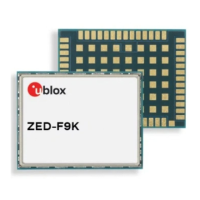ZED-F9K-Integration manual
Interface Configuration groups
USB CFG-USB-*, CFG-USBINPROT-*, CFG-USBOUTPROT-*
I2C CFG-I2C-*, CFG-I2CINPROT-*, CFG-I2COUTPROT-*
SPI CFG-SPI-*, CFG-SPIINPROT-*, CFG-SPIOUTPROT-*
Table 2: Interface configurations
3.1.4.2 Message output configuration
This product supports two protocols for output messages. One is NMEA and the other one is a u-
blox proprietary "UBX" protocol. NMEA is a well-known industry standard, used mainly for providing
information about position, time and satellites. UBX messages can be used to configure the receiver
and also to periodically provide information about position, time and satellites. With the UBX
protocol it is easy to monitor the receiver status and get much deeper information about the receiver
status. The rate of NMEA and UBX protocol output messages are configurable and it is possible to
enable or disable single NMEA or UBX messages individually.
If the rate configuration value is zero, then the corresponding message will not be output. Values
greater than zero indicate how often the message is output.
For periodic output messages the rate relates to the event the message is related to. For example,
the UBX-NAV-PVT (navigation, position, velocity and time solution) is related to the navigation
epoch. If the rate of this message is set to one (1), it will be output for every navigation epoch. If the
rate is set to two (2), it will be output every other navigation epoch. The rates of the output messages
are individually configurable per communication interface. See the CFG-MSGOUT-* configuration
group.
Some messages, such as UBX-MON-VER, are non-periodic and will only be output as an answer to
a poll request.
The UBX-INF-* and NMEA-Standard-TXT information messages are non-periodic output messages
that do not have a message rate configuration. Instead they can be enabled for each communication
interface via the CFG-INFMSG-* configuration group.
All message output is additionally subject to the protocol configuration of the
communication interfaces. Messages of a given protocol will not be output until the protocol
is enabled for output on the interface (see the Communication interface configuration).
3.1.4.3 GNSS signal configuration
The GNSS constellations and bands are configurable with configuration keys from configuration
group CFG-SIGNAL-*. Each GNSS constellation can be enabled or disabled independently. A GNSS
constellation is considered to be enabled when the constellation enable key is set and at least one
of the constellation's band keys is enabled.
The following table shows possible configuration key combinations for the GPS constellation.
Constellation key
CFG-SIGNAL-GPS_ENA
Band key
CFG-SIGNAL-GPS_L1CA_ENA
Band key
CFG-SIGNAL-GPS_L2C_ENA
Constellation
enabled?
false (0) false (0) false (0) no
false (0) false (0) true (1) no
false (0) true (1) false (0) no
false (0) true (1) true (1) no
true (1) false (0) false (0) no
true (1) false (0) true (1) Unsupported
combination
UBX-20046189 - R01
3 Receiver functionality Page 11 of 105
C1-Public Early production information

